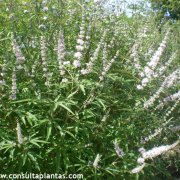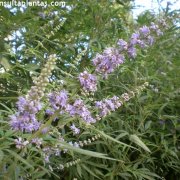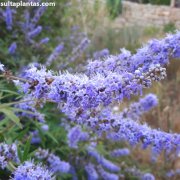Care of the shrub Vitex agnus-castus or Chasteberry |
|
The genus Vitex, family Lamiaceae, comprises 250 species of trees and shrubs native to temperate, tropical and subtropical regions of all continents. Some species are: Vitex agnus-castus, Vitex trifolia, Vitex negundo, Vitex lucens, Vitex megapotamica, Vitex cymosa, Vitex lignum-vitae. Common names: Chaste tree, Chastetree, Chasteberry, Abraham's balm, Lilac chastetree, Monk's pepper. This species is native to the Mediterranean region. They are aromatic deciduous shrubs with long, thin branches and a compact bearing that reach 4 meters (13.12 feet) in height. They have greenish-gray leaves formed by 5-7 leaflets. The flowers are small, purple or white, and appear on long erect spikes. They bloom in summer. Chaste tree is used as windbreaks, to form aromatic hedges and as isolated specimens. It's ideal plants for Mediterranean gardens by the sea. Vitex agnus-castus is an easy-to-grow plant that needs full sun or light shade exposure and high temperatures. Lilac chastetree can grow in any type of well-drained soil. The planting is done in spring. Water regularly so that the soil is always wet (never flood); wait for the substrate surface to dry. Fertilize in autumn with compost, with humus or with manure. Prune intensively in spring. Vitex agnus-castus is a fast growing shrub and quite resistant to the usual pests and diseases. Monk's pepper is propagated from seeds sown in spring or by cuttings in fall. |
Images of the shrub Vitex agnus-castus or Chasteberry |
Find plants
Vitex agnus-castus or Chasteberry | Care and Growing
© 2025 FavThemes








